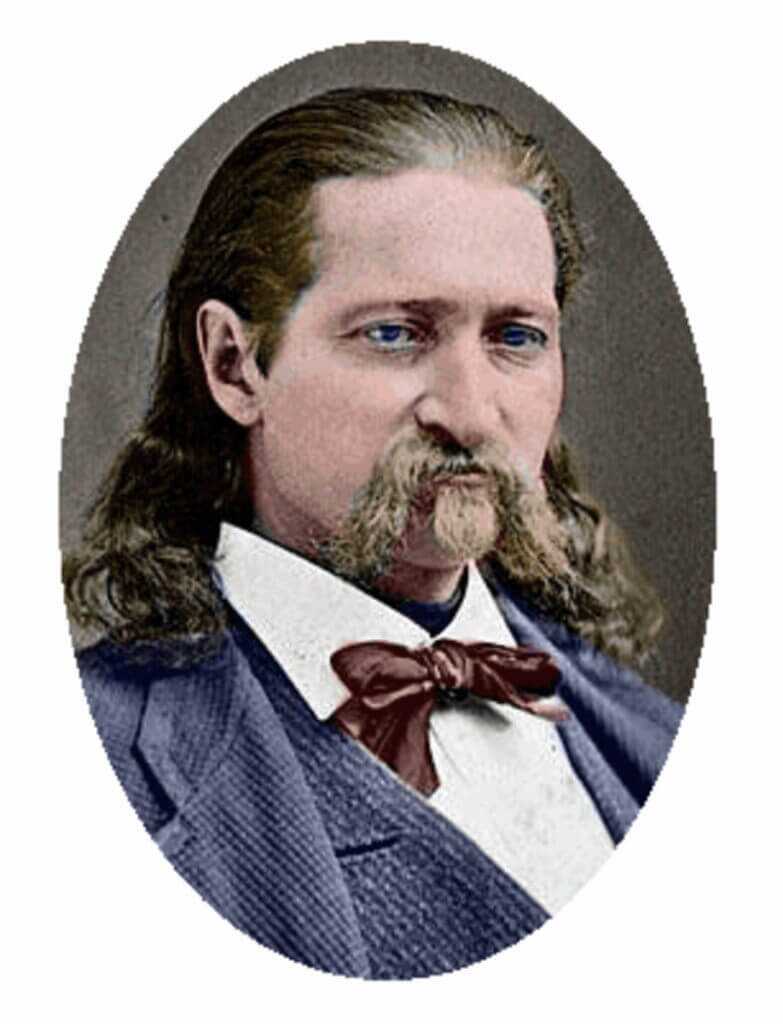
The fourth of six children, James Butler Hickok was born in 1837 in Homer, Illinois, to parents William and Polly. William was an abolitionist whose home was a station on the Underground Railroad.
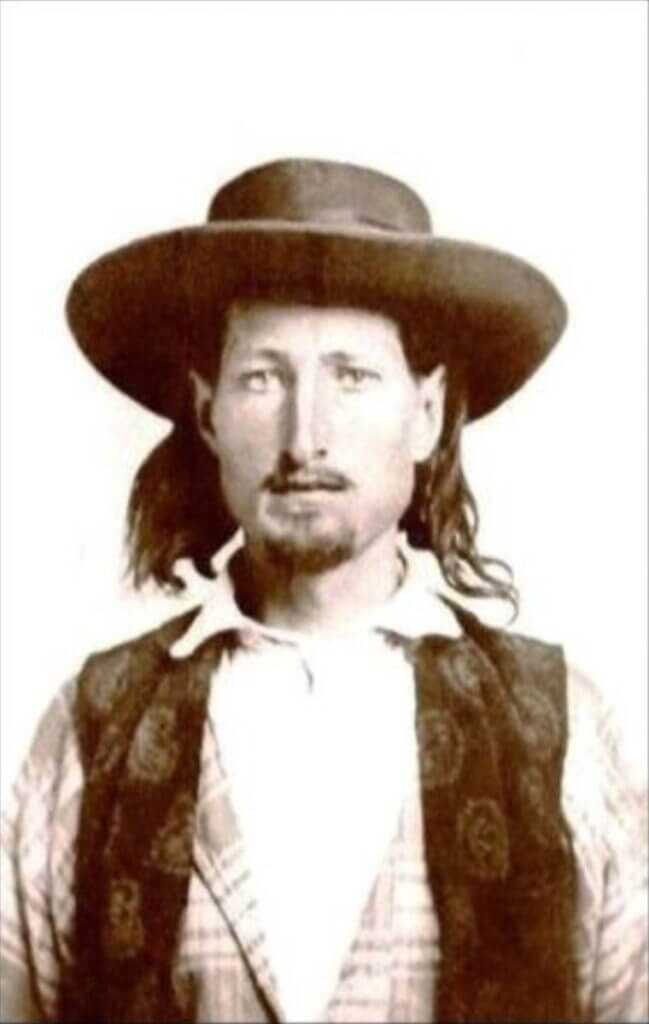
James was endowed with an unusually long nose and pouting lips, earning him the derisive moniker “Duck Bill” Hickok from some of the rough men with whom he eventually associated. James grew a bushy mustache to compensate and began calling himself “Wild Bill” instead. When he was 21 years old he adopted his dead brother’s name, William.

Cheap western print serials were the reality TV of the day, and larger-than-life figures like Hickok frequently had their exploits wildly embellished. However, enough has been verified to document Wild Bill’s ample adventure and mayhem. Just before the onset of the American Civil War Hickok was very nearly killed by a bear.
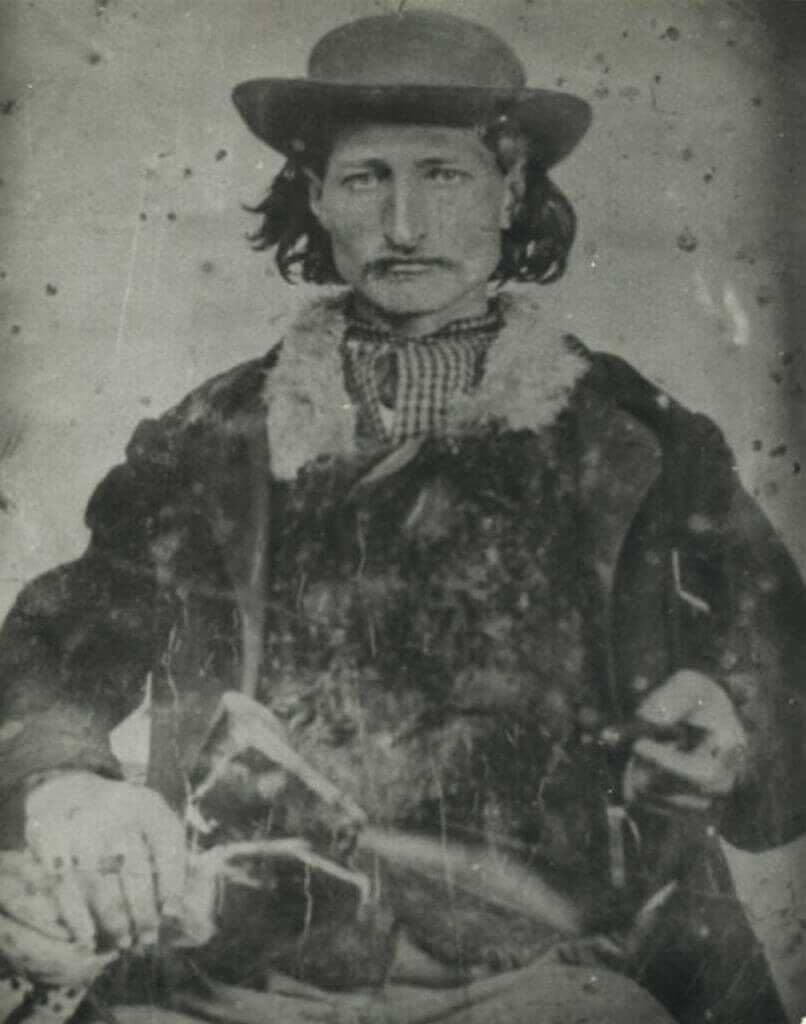
In 1860 at the age of 24 Wild Bill was driving a freight wagon from Missouri to New Mexico when he encountered a female grizzly with a brace of cubs blocking the road. Hickok dismounted his wagon and shot the bear in the head with his pistol, bouncing the round off of its skull and enraging the beast.

The bear was on him in an instant, crushing his chest and mauling him severely. Hickok got off another shot into the bear’s paw and retrieved his knife, slashing the beast’s throat and killing it. Badly injured in the chest, shoulder, and arm, Hickok was bedridden for four months recovering.
Soldier, Lawman, Manhunter, Spy

William Hickok served in the Union Army during the war where he developed a friendship with a young Buffalo Bill Cody. Cody enlisted at age seventeen as a teamster for the 7th Cavalry and ultimately won the Medal of Honor as a scout during the Indian Wars. Cody claimed to have seen Hickok in the uniform of a Confederate officer during the war, furthering Wild Bill’s legend as a Union spy.

After the war ended in 1865 Hickok made his way to Springfield, Missouri, to earn a living as a professional gambler. While there he fell out with a fellow gambler named Davis Tutt over unpaid debts and the affections of various women. Despite Tutt’s Confederate service, the two men had been friends for a time. However, Wild Bill supposedly fathered a bastard child by Tutt’s sister. Tutt was himself caught paying undue attention to Hickok’s girl du jour, a local harlot named Susanna Moore.

Their acrimony came to a head after Tutt stole Hickok’s favorite gold watch during a card game. The two men refused to play each other directly, but Tutt advised and bankrolled several of Wild Bill’s opponents in an effort at bankrupting him. During a heated high-stake game wherein Wild Bill was ahead by $200, Tutt snatched Hickok’s watch off the table claiming it as collateral for a previous debt. Tutt’s buddies were well-armed and numerous so Wild Bill had no choice but to let Tutt leave with his property. However, when Tutt boasted that he was going to wear the watch in public the following day Hickok’s fuse was lit.

Despite the ready availability of cartridge-firing revolvers, Wild Bill preferred the manual reliability of the classic .36-caliber 1851 Colt Navy. Quality control was not then what it is today, so fixed ammunition was not infrequently short-loaded or devoid of powder altogether. Using a cap-and-ball sidearm ensured that the weapon was charged properly every time. Hickok retreated to his hotel room to clean and reload his matched pair of Colts in anticipation of trouble.
The Guns

A young Samuel Colt served as a junior seaman on the brig Corvo. During a voyage to Calcutta, he observed the function of the ratchet and pawl mechanism of the ship’s capstan and resolved to adapt the design to a repeating firearm. While aboard the ship he built a wooden model of his proposed handgun.
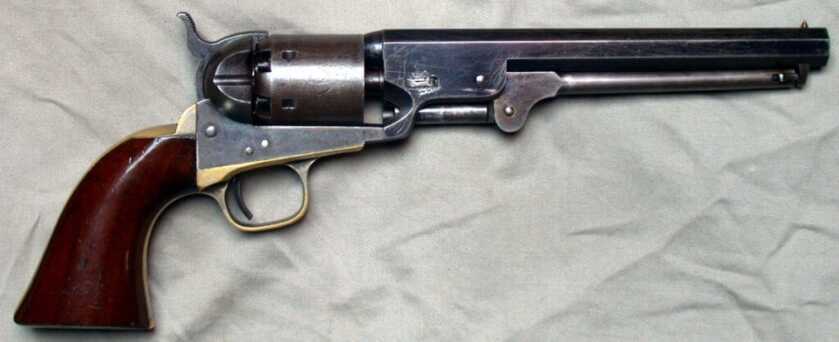
Between 1847 and 1850 Colt developed the Colt Revolving Belt Pistol of Naval Caliber. He first wanted to call the gun the Ranger. However, the title Colt 1851 Navy or simply Navy Revolver eventually stuck.
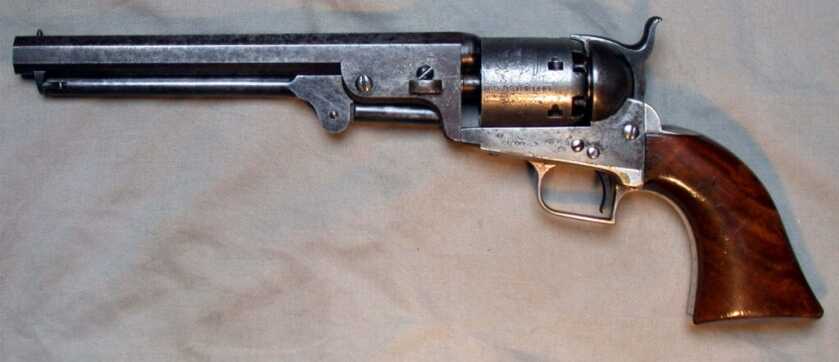
The Colt Navy was a popular weapon on both sides during the Civil War and remained in production until 1873 when it was supplanted by the famed Colt Single Action Army. Total American production numbered around 215,000 copies with another 42,000 produced in Colt’s London facility. Almost all Navy pistols were chambered in .36-caliber.

The 1851 Colt Navy fired an 80-grain pure lead ball at about 1,000 feet per second. This puts the gun solidly on par with a modern .380ACP. The front sight was a brass cone set at the muzzle that mated with a notch cut into the top of the hammer. Despite the relative crudity of this arrangement, as we shall see in a moment, the Colt Navy could be plenty accurate.

Wild Bill’s fondness for the Navy was well documented. Other flamboyant figures such as John Henry “Doc” Holliday, Ned Kelly, Robert E. Lee, and Nathan Bedford Forrest used the weapon operationally as well. There is a pivoting ramrod built into the action to facilitate seating the balls, and a subsequent cartridge conversion extended the life of the weapons. It is critical when loading the gun to slather a little grease across the ends of the chambers. I once had five rounds detonate simultaneously after I had been unduly stingy with the lube.

The Shootout
There was a failed attempt at diplomacy the next morning that took place in the town square at 10 am. Tutt brandished the watch proudly and demanded a sum for its return that Hickok disputed. As they were both professional gamblers neither man could afford to lose face lest their reputations and subsequent livelihoods suffer.

Mutual friends attempted to mediate, but Tutt dangled the pilfered watch in Hickok’s face for all the townspeople to see. The two men agreed to share a drink, but by now the damage was done. A bit before 6 pm that same day Hickok approached the square from the south, one of his Colt revolvers dangling calmly in his right hand. Hickok typically eschewed holsters when he knew trouble was afoot, preferring to tuck his matched pistols into his belt butts forward cavalry style.


The assembled crowd saw the brandished weapon and scattered, leaving Davis Tutt alone in the northwestern corner of the square. Hickok called out flatly, “Dave, here I am.” He then manually cocked his pistol and tucked it into his belt. At a range of 75 feet he then stated, “Don’t you come across here with that watch.”

Tutt uttered not a word but stood sideways with his hand resting on his pistol butt. Both men paused for a pregnant moment. Tutt then suddenly reached for his gun as did Hickok. An accomplished marksman, Wild Bill rested his Colt across his left forearm and aimed carefully.
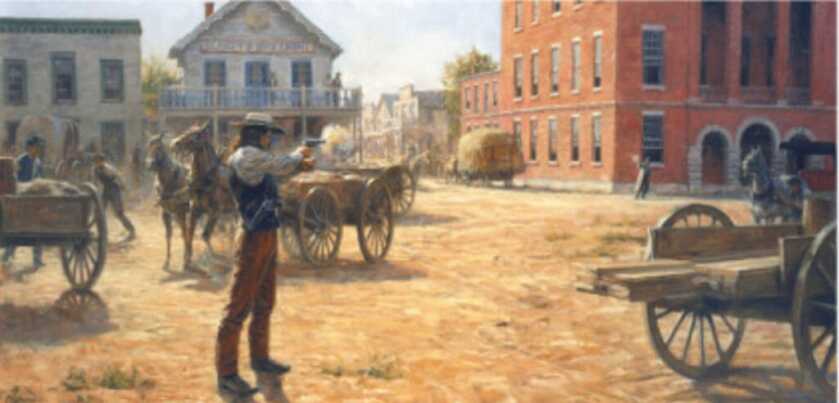
Both men loosed a single round at essentially the same moment. Tutt’s shot went wide, but Hickok’s connected on his opponent’s left side between the fifth and seventh ribs. Davis Tutt called out, “Boys, I’m killed,” before running onto the porch of the nearby courthouse and then back onto the street. There he fell, bled out, and died.
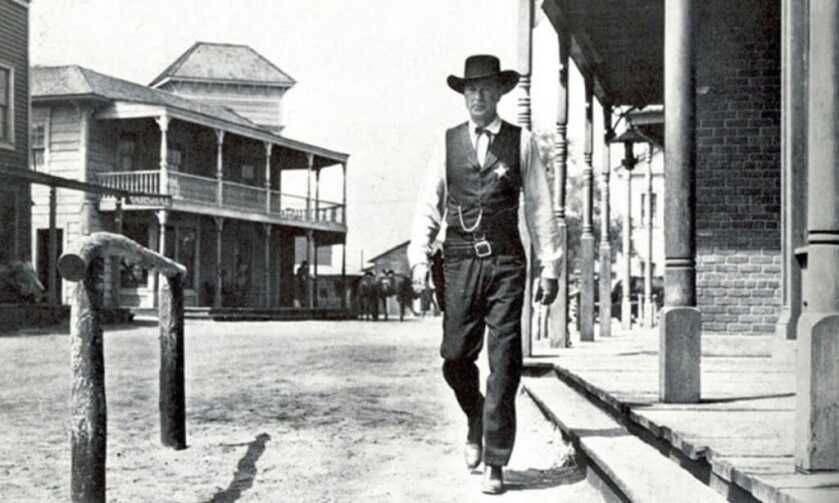
The gunfight between Wild Bill Hickok and Davis Tutt was the first documented instance of two gunmen settling their differences via an armed public showdown on the Western frontier. This performance was repeated several times in violent towns like Tombstone and Deadwood. There have also been countless iterations reproduced on screens both large and small. The depiction of a flint-eyed gunslinger defending his honor in single combat became part of the fabric Western lore, and Wild Bill Hickok blazed the trail.
The Rest of the Story

Wild Bill was arrested two days later for murder, but the charge was subsequently reduced to manslaughter. The Honorable Judge Sempronius Boyd presided over the three-day trial. Of twenty-two witnesses present on the square that day only four had their heads up so they could watch events unfold. After Judge Boyd issued confusing and contradictory instructions to the jury they deliberated “an hour or two” and acquitted Wild Bill of the crime.

Wild Bill Hickok likely killed at least six or seven men in his capacity as an affronted gambler and lawman. In August of 1876, Hickok beat a drunkard named Jack McCall badly at cards at the Nuttal and Mann’s Saloon Number 10 in Deadwood, Dakota Territory. Hickok encouraged McCall to quit the game and even gave him money for breakfast.

The following day McCall now thoroughly sober tracked down Hickok who was again busy playing cards. McCall drew his .45-caliber Colt Single Action Army and shot Hickok through the head at contact range. The bullet exited Wild Bill’s right cheek and wounded riverboat Captain William Massie in the left wrist.

The following March Jack McCall was hanged for the crime. Four years later McCall’s body was exhumed when the cemetery was relocated. The noose was found still around his neck.


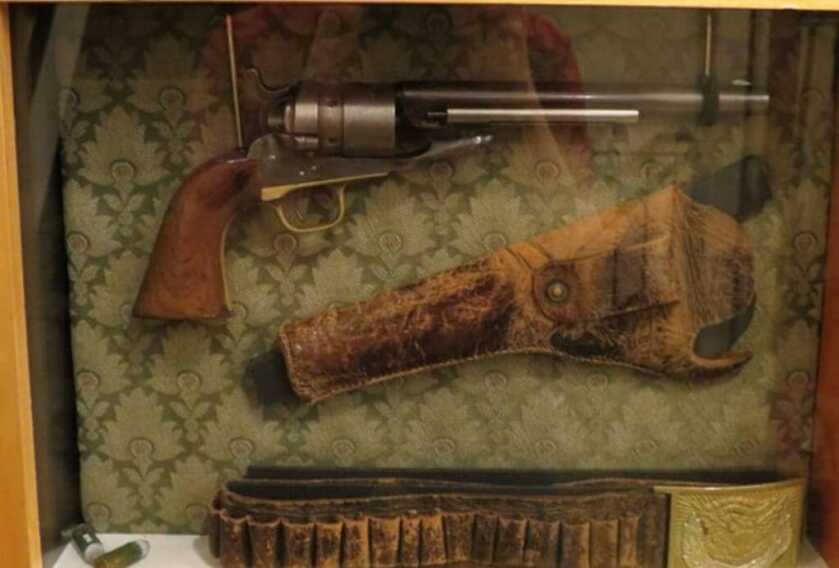


How can I get more useful info?
Thank you for sharing the information.
Great, great read, I thoroughly enjoyed it. On reading Dr Wills bio it seems he was quite successful at his every endeavor. Wow, what an impressive resume!
The bottom photo is NOT a converted navy, but rather a Richards conversion of the .44 1860 army revolver.
As I recall and I might be wrong the Confederate states made a copy of the 51 Navy, but they made it in .44 cal. The brass frames were made from church bells.
I used a pair of 51’s in CAS for many years, they were in .44 and made by Armi San Marco, They were outstanding revolvers and served me well, I almost wore them out I shot them so much.
I must say that I really enjoyed signing up for a match and having another shooter say something like “You really plan to compete with those things”? And at the end of the day I not only won the black powder category but beat that person by a mile. Of course that was close to 40 years ago lol.
Thanks for the great story and memories!
The Confederacy did make copies of the 1851 navy, but NONE was in .44 caliber. All the .44 “navy” revolvers you see are modern hybrid replicas: 1860 army frame and cylinder with a navy style barrel.
I have had too much to drink more than once in the old saloon where Bill was shot. We would sometimes take some beer and go up to Bill’s Grave where Potato Creek Johnny was also buried. I doubt that he ever knew Calamity Jane. Her father worked on ranches near our place here in Wyoming.
Liked the story very much. Liked the pictures included.
Nice Job.
Such flamboyant and aggressive men. This is the American heritage and why we will never be conquered.
I think we are from within just like every other civilisation we are on the down hill side now picking up speed. I truly wish you were right but the writing is on the wall.
Enjoyed your article,now waiting for your book on other western gunfighters.
Thanks
I enjoyed Dr. Dabbs apparently well researched stories. I am sure my law enforcement training is the reason for not having my back to people/activity when enjoying a restaurant meal. I always sit with a overall view of my surroundings … facing out from a wall. I have a feeling of being “in control” of what is occurring.
Will Dabbs, the Poet who don’t know it?
‘Hickok’s girl du jour, a harlot named Moore’
JK!
Charlie Rich is the man who dealt the hand to Wild Bill. He is buried in Miamiville, Ohio just east of Cincinnati. There is an etching of the dead man’s hand on his tombstone. We would visit there as youngster and legend said you could sometimes see Wild Bill’s ghost looking for a new hand. Good stuff.
Mr. Dabbs-as an Army Officer surely you should know that Buffalo Bill didn’t “win” the Medal of Honor but rather was awarded the Medal of Honor.
WHEN will you publish your stories? Thoughtful, well researched, entertaining and excellent subject variety- calls for a book. Much as I prefer paper, maybe an e-book to start?
Thank you!
Owning a piece of history like the pair of 1851Colt Navy’s would make me proud. The headshot that Hickok received that ended his life shows the lawlessness of the times. Found it ironic that he was killed with a Smith & Wesson #2 revolver on his person at the time. Wild Bill showed great taste of fine weaponry during this period of Western history.
Wild Bill was born in Troy Grove Illinois. I live there and there is a big statue
I believe the town was originally named Homer and later was renamed Troy Grove.
I hope this article is a preview of a forthcoming book. The interesting photos, illustrations, and unadorned narrative would help balance the current rewriting of our country’s history in politically correct terminology.
Good article. One negative comment . . . one does not “win” the Medal of Honor.
Many, many stories have been told and written about Wild Bill Hickok. The facts get twisted I’m sure. Dr.Dabbs did a good job and made it interesting. I have read that the distance between Bill and Tutt was about 75 yds. Further enhancing Wild Bill’s skill with a handgun. I also read that Bill shot those Navies empty every day and cleaned and reloaded them so they would be ready. A real cool gunfighter he was, if it is true. But why would he sit at a poker game without his back to a wall baffles me. Thank you, Dr. Dabbs, for a good read.
Maybe it is because most poker tables are NOT pushed up to a wall. As people enter and leave the game, you don’t want to make everyone get up and force the entering or leaving player to shimmy past everyone else’s chip stacks so they can get to a seat that has their back to a wall. That is a recipe for unnecessary fights.
He asked the man who had his back to the wall to change seats with him but the guy wouldn’t trade seats
Nice history article, but I have to say this, nobody ever “won the metal of Honor” it is awarded, not won. Incorrect terminology makes it sound like a contest, minimizing the actions of America’s greatest heroes.
Great Article Dr. Dabbs.
Keep up the gr8 work Dr. Dabbs. Your renditions are both interesting and accurate.
Without stories like these we wouldn’t know the real history of gunfighters. Thanks
I thoroughly enjoyed the article. Dr Dabbs seems an original. Keep writing Doc.
Used to walk the beat as a police officer where Hickock shot Tutt, many years later, of course….lol..
The converted “navy” in the last photo is actually a converted ARMY. Note the rebated cylinder, as well as the shape of the barrel.
I really enjoy these stories, and I wouldn’t know much about them if not for your writing. Thank you!
That conversion sure looks like an 1860 Army in .44. The Navy never had a stepped cylinder like that, only the Army. The stepped cylinder was needed to accommodate the larger ball while the rear section was the same diameter as the Navy (and the Navy frame) on which the .44 was built. (The Army also had a longer grip and grip frame.)
They are called Navy because of the Texas Navy use at the battle of Campeche, where the Texas Navy was able to defeat a larger force due in large part to the Colt revolvers. The purchase of the revolvers also kept Colt from bankruptcy and thats why the battle scene is engraved on the cylinders. Going into a gunfight or battle with one of those guns would also require a cast iron pair.